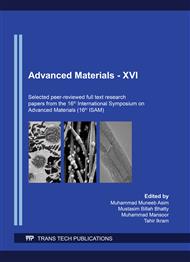[1]
J. Jiang, J.Pi, J.Cai, The Advancing of Zinc Oxide Nanoparticles for Biomedical pplications, Bioinorganic chemistry and applications 1062562 (2018) 1-18.
DOI: 10.1155/2018/1062562
Google Scholar
[2]
S.P. Thomas, E.J. Mathew, C.V. Marykutty, Synthesis and Effect of Surface Modified Nano ZnO in Natural Rubber Vulcanization, J. App. Poly. Sci. 124 (2012) 3099–3107.
DOI: 10.1002/app.35349
Google Scholar
[3]
D. Vaishnav, R.K. Goyal, Thermal and Dielectric Properties of High Performance Polymer/ZnO Nanocomposites 64 (2014) 01-10.
Google Scholar
[4]
J.W. Lee, C. Jin, S.J. Hong, S.K. Hyun, Microstructure and Density of Sintered ZnO Ceramics Prepared by Magnetic Pulsed Compaction, Adv. Mat. Sci. Eng. 2514567 (2018) 1-7.
DOI: 10.1155/2018/2514567
Google Scholar
[5]
H.B. Kamal, M.S. Antonious, M.A. Mekewi, A.M. Badawi, A.M. Gabr, K.E. Baghdady, Nano ZnO/amine composites antimicrobial additives to acrylic paints, Egyptian J. Petroleum 24 (2015) 397-404.
DOI: 10.1016/j.ejpe.2015.10.005
Google Scholar
[6]
S.K. A.-Dawery, Z.A.A. Khammas, T.A. Abdulla, Purification of Zinc Oxide Using Direct Thermal Process by Petroleum Coke, Iraqi J. Chem. Petro. Eng. 10 (2009) 35-41.
Google Scholar
[7]
A.O. Oyelola, D.A. Abdu, A.D. Victor, I. Magnus, B.M. Bosan, A.B. Oyebode, Extraction of a Low Grade Zinc Ore using Gravity and Froth Flotation Methods, J. Appl. Sci. Environ. Manage 20 (2016) 903-908.
DOI: 10.4314/jasem.v20i4.1
Google Scholar
[8]
M. Jabłońska, R. Palkovits, Nitrogen oxide removal over hydrotalcite-derived mixed metal oxides Catalysis Science & Technology, Catalysis Sci. Tech. 6 (2016) 49-72.
DOI: 10.1039/c5cy00646e
Google Scholar
[9]
R.M. Alwan, Q.A. Kadhim, K.M. Sahan, R.A. Ali, R.J. Mahdi, N.A. Kassim, A.N. Jassim, Synthesis of Zinc Oxide Nanoparticles via Sol – GelRoute and Their Characterization, Nanosci. Nanotech. 5(2015) 1-6.
Google Scholar
[10]
C.C. Yu, W.H. Lan, K.F. Huang, Indium-Nitrogen Codoped Zinc Oxide Thin Film Deposited by Ultrasonic Spray Pyrolysis on n-(111) Si Substrate: The Effect of Film Thickness, J.Nanomat. 861234 (2014) 1-7.
DOI: 10.1155/2014/861234
Google Scholar
[11]
Z.M. Khoshhesab, M. Sarfaraz, M.A. Asadabad, Preparation of ZnO Nanostructures by Chemical Precipitation Method J. Nanomat.41 (2011)814-819.
DOI: 10.1080/15533174.2011.591308
Google Scholar
[12]
A.K. Radzimska, T. Jesionowski, Zinc Oxide-From Synthesis to Application: A Review, Materials (Basel) 7 (2014) 2833–2881.
DOI: 10.3390/ma7042833
Google Scholar
[13]
A.A. Oladiran, I.A.M. Olabisi, Synthesis and characterization of ZnO nanoparticles with Zinc Chloride as Zinc source, Asian J. Nat. App. Sci. 2 (2013) 41-44.
Google Scholar
[14]
G.Madhumitha, J.Fowsiya, N. Gupta, A. Kumar, M. Singh, Green synthesis, characterization and antifungal and photocatalytic activity of Pithecellobiumdulce peel–mediated ZnO nanoparticles, J. Phy. Chem. Solids 127 (2019) 43-51.
DOI: 10.1016/j.jpcs.2018.12.005
Google Scholar
[15]
P. Bindu, S. Thomas, Estimation of lattice strain in ZnO nanoparticles: X-ray peak profile analysis, J. Theo. App. Phy. 8 (2014) 123-134.
DOI: 10.1007/s40094-014-0141-9
Google Scholar
[16]
A. Fujimoto, Y. Yamada, M. Koinuma, S. Sato, Origins of sp3C peaks in C1s X-ray Photoelectron Spectra of Carbon Materials, Anal.Chem. 88 (2016) 6110-6114.
DOI: 10.1021/acs.analchem.6b01327
Google Scholar
[17]
Y. Li, Q. Han, T.W. Kim, W. Shi, Synthesis of Wurtzite - Zincblende Cu2ZnSnS4 and Cu2ZnSnSe4 Nanocrystals: Insight into the Structural Selection of Quaternary and Ternary Compounds influenced by Binary nucleus, Nanoscale 7 (2014) 3425-3896.
DOI: 10.1039/c3nr05358j
Google Scholar
[18]
C. Wu, T.W. Kim, T. Guo, F. Li, Unique visible-light-assisted field emission of tetrapodshaped ZnO/reduced graphene-oxide core/coating nanocomposites, Sci. Rep. 6 (2016) 38613.
DOI: 10.1038/srep38613
Google Scholar
[19]
E.G. Goh, X.Xu, P.G.McCormick, Effect of particle size on the UV absorbance of zinc oxide nanoparticles, Scri.Mater. 78 (2014) 49-52.
DOI: 10.1016/j.scriptamat.2014.01.033
Google Scholar


